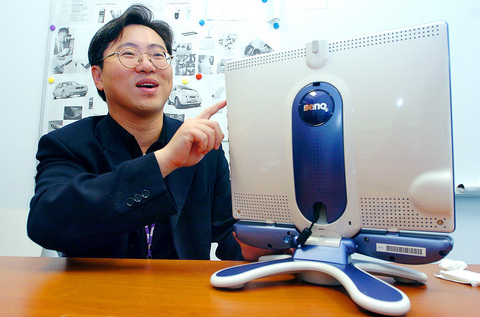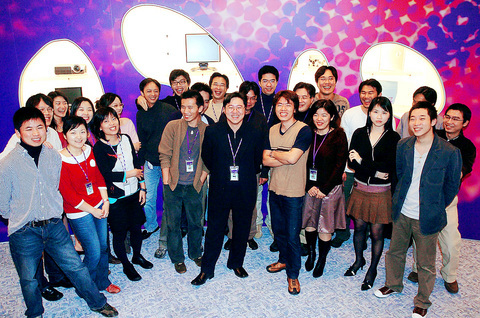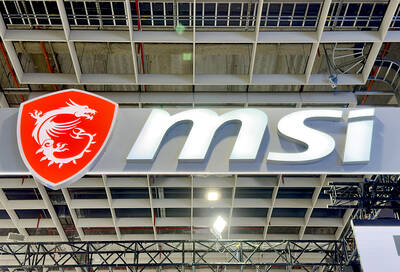How does a company get out of the quagmire of the free-fall in gross margins that have long plagued Taiwanese electronics makers? Build a brand. That is what Taiwanese consumer-electronics maker BenQ Corp (明基電通) opted for three years ago.
Taking a road rarely travelled by most Taiwanese companies, BenQ's expansion into own-brand business has converted a former skeptic.

PHOTO: GEORGE TSORNG, TAIPEI TIMES
"It is the biggest adventure I've ever had in my life [to join the stable of world-class brands]. ...Now we are feeling more comfortable about it [the decision]," BenQ chairman Lee Kun-yao (李焜耀) said recently.

PHOTO: GEORGE TSORNG, TAIPEI TIMES
Most Taiwanese electronics manufacturers still stick to making products for international computer hardware vendors such as Dell Inc and Hewlett-Packard Co. Over 70 percent of the world's laptop computers are made by Taiwanese manufacturers, but few of them carry local names.
BenQ is one of them. In just a few years, BenQ has emerged as an up-and-coming brand both at home and abroad. The purple butterfly-shaped corporate logo is mushrooming from its home turf to Europe.
Powerful Chinese brands, by contrast, have a low brand awareness outside the country, despite companies' aggressive moves to expand overseas by acquiring multinationals. The latest case in point is Lenovo Group Ltd's (
BenQ will not consider using this strategy to boost its overseas market position, Lee said, as the Taiwanese company has already made significant progress in foreign markets, especially in Europe.
A quarter of BenQ's total sales was recorded in the European market, where people favor trendy products, the company said.
Own-brand business made up around 40 percent of BenQ's total sales in the current quarter and is expected to exceed that ratio next year, well ahead of the aim to boost brand-name operations to account for half of the sales in 2008, Lee said.
The remaining 60 percent came from OEM (original equipment manufacturing) business. BenQ makes mobile phones for the world's top cellphone vendor Nokia Oyj and makes LCD monitors for Dell Inc.
With the increasing contribution from its own-brand operations, BenQ secured a gross margin of 11 percent in the third quarter, while Compal Electronics Inc (仁寶電腦), the world's second-largest notebook computer contract maker, struggled to sustain the margin at 5 percent.
A frequent question is how BenQ, a new brand from Taiwan, diverted consumers' eyes from established players in just three years?
"BenQ is quite right in its brand strategy. Take a look at its faster-than-expected brand expansion and you'll find it did work," said Steven Tseng (
Talking about BenQ's brand positioning, Lee said "we hope to bring enjoyment to our customers through our products."
The clear brand strategy saved BenQ half the time its local predecessors such as Acer Inc needed to boost brand awareness, Tseng said.
But, novel industrial design has been key to establishing the brand concept in BenQ's electronic devices, from digital music players to liquid-crystal-display (LCD) televisions, Tseng said.
"BenQ is gradually cultivating a cult following among its users, like Apple Computer Inc did with its popular iMacs and iPods. This is the highest goal a brand can achieve," Tseng said.
Lifestyle design was BenQ's core competitiveness area when the brand started out in 2001, Lee said.
"People were suspicious of this strategy. But, now we see followers taking the same steps as BenQ," Lee said.
Two years ago, Asustek Computer Inc (華碩電腦), the world's largest motherboard maker, established a design center for its branded computers under the "ASUS" brand.
However, no significant progress was made until recently, when Asustek tapped into the consumer electronics market with its first mobile phone hitting local stores early this year.
Even before Asustek, BenQ set up its Lifestyle Design Center in 2001 to blend the brand's core value, "enjoy technology," with customers' anticipation for new electronic gadgets.
The center's location reflects its importance.
Situated on the 13th floor of BenQ's 14-storey office building in Taipei's Neihu district, the center has specially-designed stairs spiraling up directly to the company's core management on the top floor.
Explaining BenQ's product-design concept, the center's director Manfred Wang (王千睿) said that "product design is extremely important for us to differentiate between BenQ's existing brands and IT (information technology) brands. BenQ is a consumer-electronics brand."
BenQ sent its designers overseas to research how the target market lives and what their expectations were of new electronics, the 38-year-old Wang said.
"Design is not merely about the look of a product. But, aesthetics should not overrule functionality," he said.
Here is an example: BenQ's FP783 LCD monitor, on the cover of Business Weekly's July 5 issue, is equipped with graceful creamy butterfly-wing speakers and a purple base station, which can be folded away to make it more mobile.
The design team's work has received a positive response. The team, consisting of a mere 70 designers -- about one-seventh of the 470-strong team of South Korean electronics giant Samsung Electronics Co -- has notched up 58 international product-design awards in the past three years.
In the 10 years since Samsung set up its lifestyle design laboratory, the South Korean consumer-electronics maker has won only 100 similar awards with a larger design team, Wang said.
BenQ plans to expand its design center team to around 100 next year by increasing its members in Taipei and establishing a Chinese design center in Suzhou. The aim is for the team to increase to 200 by 2006, Wang said.
Rapid growth in own-brand sales has impressed investors and prompted worldwide attention, but it may be too early to say whether BenQ will succeed in becoming a power brand like Samsung, analysts said.
A conflict between own-brand operation and OEM business is the biggest challenge before the young brand can rely on brand-name products to make profits, Yuanta Core Pacific's Tseng said.
A slim portion of the company's earnings now come from own-brand operations, BenQ chief financial executive Eric Yu (
BenQ's shrinking handset OEM business is a case in point, Tseng said. Motorola Inc, which used to be BenQ's biggest client, recently switched its OEM partnership to another local mobile phone maker, Compal Communications Inc (華寶通訊).
That happened to coincide with BenQ's fast expansion in the branded mobile-phone area in Taiwan as well as emergent markets, he said.
Looking at BenQ's bottom line, analysts note that half of an estimated NT$8.23 billion in earnings come from its liquid-crystal-display (LCD) affiliate AU Optronics Corp (友達光電) rather than the core business.
Heavy marketing expenditure, which is seen as the norm for companies to boost brand awareness, is also a concern.
"BenQ skimps on brand marketing. But we also fear that drastic increases in spending could be a burden," said Vincent Chen (
BenQ has in the past years spent about 6 percent of its total annual sales to market branded electronics, according to BenQ's Yu. The percentage is well below the 10 percent Samsung spends every year.
"Running a brand is a long-term effort. It is hard to judge now whether BenQ will succeed, but BenQ has already caught the world's attention," Chen said.

Meta Platforms Inc offered US$100 million bonuses to OpenAI employees in an unsuccessful bid to poach the ChatGPT maker’s talent and strengthen its own generative artificial intelligence (AI) teams, OpenAI CEO Sam Altman has said. Facebook’s parent company — a competitor of OpenAI — also offered “giant” annual salaries exceeding US$100 million to OpenAI staffers, Altman said in an interview on the Uncapped with Jack Altman podcast released on Tuesday. “It is crazy,” Sam Altman told his brother Jack in the interview. “I’m really happy that at least so far none of our best people have decided to take them

BYPASSING CHINA TARIFFS: In the first five months of this year, Foxconn sent US$4.4bn of iPhones to the US from India, compared with US$3.7bn in the whole of last year Nearly all the iPhones exported by Foxconn Technology Group (富士康科技集團) from India went to the US between March and last month, customs data showed, far above last year’s average of 50 percent and a clear sign of Apple Inc’s efforts to bypass high US tariffs imposed on China. The numbers, being reported by Reuters for the first time, show that Apple has realigned its India exports to almost exclusively serve the US market, when previously the devices were more widely distributed to nations including the Netherlands and the Czech Republic. During March to last month, Foxconn, known as Hon Hai Precision Industry

PLANS: MSI is also planning to upgrade its service center in the Netherlands Micro-Star International Co (MSI, 微星) yesterday said it plans to set up a server assembly line at its Poland service center this year at the earliest. The computer and peripherals manufacturer expects that the new server assembly line would shorten transportation times in shipments to European countries, a company spokesperson told the Taipei Times by telephone. MSI manufactures motherboards, graphics cards, notebook computers, servers, optical storage devices and communication devices. The company operates plants in Taiwan and China, and runs a global network of service centers. The company is also considering upgrading its service center in the Netherlands into a

Taiwan’s property market is entering a freeze, with mortgage activity across the nation’s six largest cities plummeting in the first quarter, H&B Realty Co (住商不動產) said yesterday, citing mounting pressure on housing demand amid tighter lending rules and regulatory curbs. Mortgage applications in Taipei, New Taipei City, Taoyuan, Taichung, Tainan and Kaohsiung totaled 28,078 from January to March, a sharp 36.3 percent decline from 44,082 in the same period last year, the nation’s largest real-estate brokerage by franchise said, citing data from the Joint Credit Information Center (JCIC, 聯徵中心). “The simultaneous decline across all six cities reflects just how drastically the market